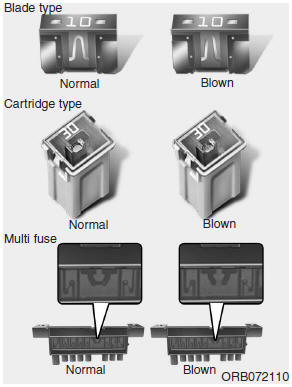 Hyundai Accent: Fuses
Hyundai Accent: Fuses

A vehicle’s electrical system is protected from electrical overload damage by fuses.
This vehicle has 2 fuse panels, one located in the driver’s side panel bolster, the other in the engine compartment.
If any of your vehicle’s lights, accessories, or controls do not work, check the appropriate circuit fuse. If a fuse has blown, the element inside the fuse will be melted.
If the electrical system does not work, first check the driver’s side fuse panel. Before replacing a blown fuse, disconnect the negative battery cable.
Always replace a blown fuse with one of the same rating.
If the replacement fuse blows, this indicates an electrical problem. Avoid using the system involved and immediately consult an authorized HYUNDAI dealer.
Three kinds of fuses are used: blade type for lower amperage rating, cartridge type, and multi fuse for higher amperage ratings.
![]() WARNING - Fuse replacement
WARNING - Fuse replacement
- Never replace a fuse with anything but another fuse of the same rating.
- A higher capacity fuse could cause damage and possibly a fire.
- Never install a wire or aluminum foil instead of the proper fuse - even as a temporary repair. It may cause extensive wiring damage and a possible fire.
CAUTION
Do not use a screwdriver or any other metal object to remove fuses because it may cause a short circuit and damage the system.
![]() NOTICE
NOTICE
The actual fuse/relay panel label may differ from equipped items.
![]() CAUTION
CAUTION
- When replacing a blown fuse or relay with a new one, make sure the new fuse or relay fits tightly into the clips The incomplete fastening fuse or relay may cause the vehicle wiring and electric systems damage and a possible fire.
- Do not remove fuses, relays and terminals fastened with bolts or nuts. The fuses, relays and terminals may be fastened incompletely, and it may cause a possible fire. If fuses, relays and terminals fastened with bolts or nuts are blown, consult an authorized HYUNDAI dealer.
- Do not input any other objects except fuses or relays into fuse/relay terminals such as a driver or wiring. It may cause contact failure and system malfunction.
 Radial-ply tires
Radial-ply tires
Radial-ply tires provide improved tread life, road hazard resistance and smoother
high speed ride. The radial- ply tires used on this vehicle are of belted construction,
and are selected to comple ...
 Instrument panel fuse replacement
Instrument panel fuse replacement
1. Turn the ignition switch and all other switches off.
2. Open the fuse panel cover.
3. Pull the suspected fuse straight out. Use the removal tool provided in the
engine compartment fuse pane ...
See also:
Adjustment
1.
After loosening the tail gate hinge (A) mounting bolt, adjust
the tail gate by moving it up or down, or right or left.
2.
Adjust the tai ...
Removal
1.
Disconnect the negative (-) battery terminal.
2.
Remove the crash pad lower panel.
(Refer to the BD group - "Crash pad")
...
Installation
•
Do not turn the ignition switch ON and do not contact
the battery cable while replacing the ...
Hyundai Accent Manuals
- Hyundai Accent 2017-2022 Service Manual
- Hyundai Accent 2010-2025 Owners Manual
- Hyundai Accent 2010-2025 Service Manual
